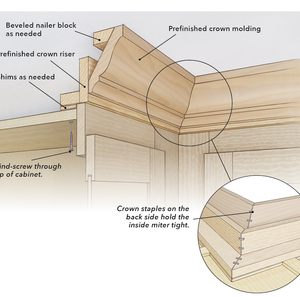*
This is a stairway I did 5 years ago. It consisted of a small curved freestanding section, and an upper straight freestanding section. It had to be built absolutely without newel posts. Every sixth brass pipe had an iron rod epoxied inside with the iron rod extending down into the subfloor. It worked out being very rigid. There were 154 brass balusters in the whole balustrade. Please excuse the poor quality shots as they were digital pictures of pictures out of my scrapbook.
Discussion Forum
Discussion Forum
Up Next
Video Shorts
Featured Story

Framing the floor inside a crawlspace foundation keeps a gable-end addition close to grade.
Highlights
"I have learned so much thanks to the searchable articles on the FHB website. I can confidently say that I expect to be a life-long subscriber." - M.K.
Fine Homebuilding Magazine
- Home Group
- Antique Trader
- Arts & Crafts Homes
- Bank Note Reporter
- Cabin Life
- Cuisine at Home
- Fine Gardening
- Fine Woodworking
- Green Building Advisor
- Garden Gate
- Horticulture
- Keep Craft Alive
- Log Home Living
- Military Trader/Vehicles
- Numismatic News
- Numismaster
- Old Cars Weekly
- Old House Journal
- Period Homes
- Popular Woodworking
- Script
- ShopNotes
- Sports Collectors Digest
- Threads
- Timber Home Living
- Traditional Building
- Woodsmith
- World Coin News
- Writer's Digest


















Replies
*
more
*and more:
*step closeup
*gooseneck/u-turn detail
*balcony
*Beautiful Stan!-What makes that railing strong? I mean what keeps it from wiggling? Is it the curve,or do those brass rods go pretty deep? What kind of adhesive do you use to keep the rods from turning?Bob
*beauty Stan- how often do you get one without newel posts? I like how it seems so open
*Bob-Greg---thanks I epoxied 5/8 inch rods inside the 3/4 o.d. brass pipes. I made a jig that guided a 5/8 paddle bit level both ways into the subfloor. They were then epoxied into the hole which was 8 inches deep. With every 6th one done this way, it was real stiff. This is the first and to date, the only stairs I have built without newels. I experimented in my shop and came up with one every six as satisfactory. I would have put as many as necessary as I cant stand railings that wiggle. The curved balcony section only needed the epoxied balusters at the gooseneck. The curve naturally supplies the stiffness. If you picture the "footprint" that the railing makes across the floor--that will give you an idea of why it is stronger. A straight rail is easier to wiggle because of its inherently narrow "footprint". A curved rail has a much wider "footprint".